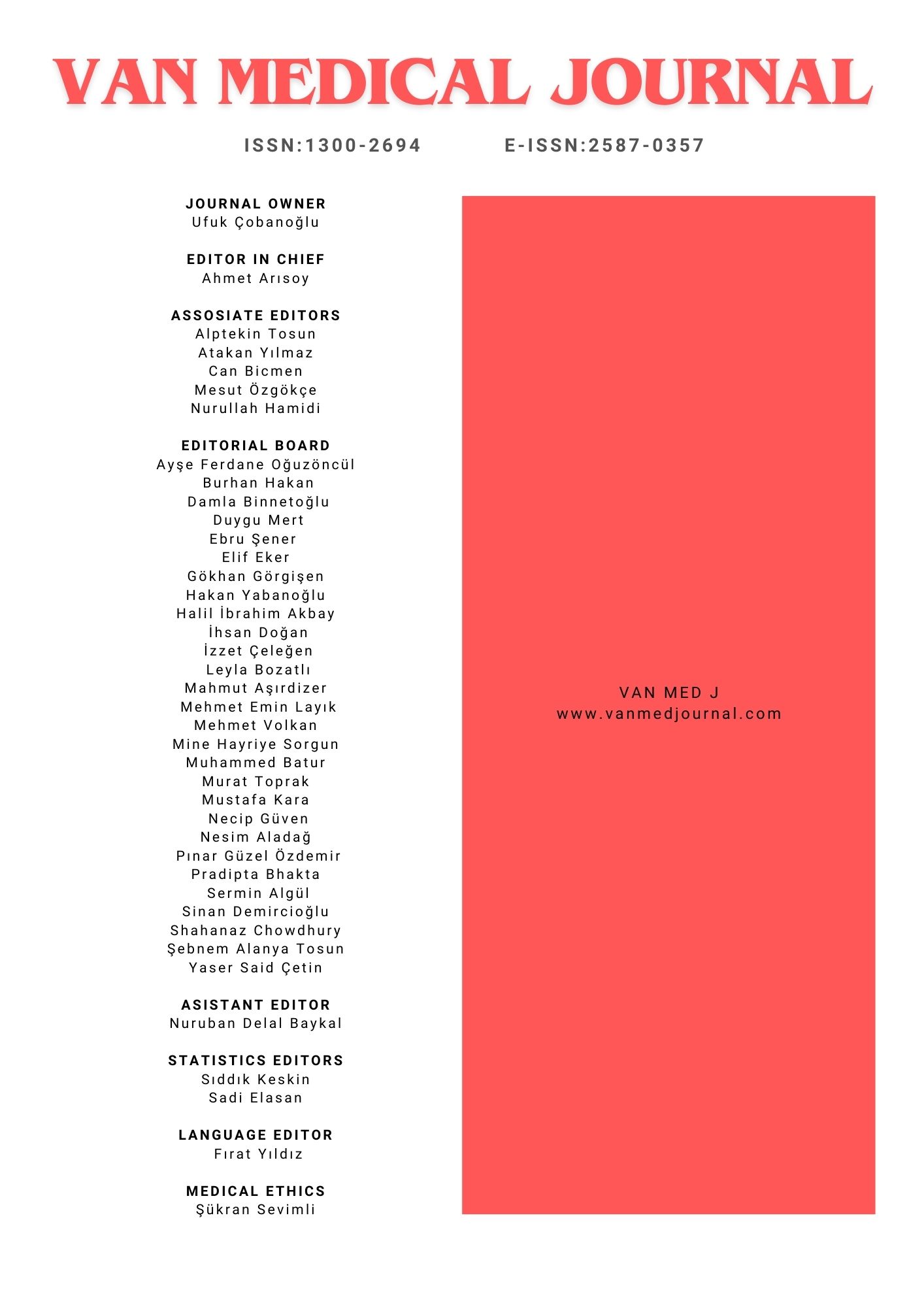Urinary culture results in childhood urinary tract infection in Sivas, Turkey: Which could be the first treatment choice?
Ayşegül Cebe1, Adnan Ayvaz2, Nazan Yıldız3, Selma Çetinkaya41Sivas Numune Hastanesi, Pediatri Kliniği, SİVAS2Cumhuriyet Üniversitesi Tıp Fakültesi Hastanesi, Pediatri AD, SİVAS
3Sivas Numune Hastanesi, Mikrobiyoloji Kliniği, SİVAS
4Cumhuriyet Üniversitesi Tıp Fakültesi Hastanesi, Tıp Eğitimi AD, SİVAS
Aim: Nowadays, it has become quite difficult to set on empiric treatment of the urinary tract infections (UTI) due to the levels of antibiotic resistance showing local differences. In this study, we aimed to find out what the local antibiotic resistance in Sivas is and we also wanted to observe whether this resistance shows differences between different age groups. Methods: One hundred fifty children who applied to pediatrics policlinic of Sivas Numune Hospital with urinary system complaints or diagnosed to have (UTI) while hospitalizing and with positive urinary culture results were included in the study. There were no known chronic disorders or no frequent recurrence of UTI history in the patients. The subjects were divided into three groups as 1) under 1 year old; 2) between 1-5 years old; 3) over 5 years old. Then the frequency of the pathogens was examined in terms of the resistance levels occurring against the antibiotics. Results: The age range of the patients was between 1 and 180 months. The reproducing pathogens were E. coli 88.7 % (n=133), K. pneumonia 6.7 % (n=10), P. mirabilis 3.3 % (n=5) and Enterococcus spp 1.3 % (n=2) respectively. While there was high resistance to amoxycilline (72.8%), ureidopenicillines (42.4), 1st generation cephalosporin, (46.4 %) and co-trimaksazole (41.1%); there was low resistance to imipenem (0.7 %), amicasin (4.6%) and 3rd generation cephalosporins (13.7%). According to thes age groups, in Group 1 (?12 months) the most effective agents were netilmicine ((12%), gentamicine (12%) and ceftriakson (16%); in addition to these, we can add cefuroxim-axetil (21.7 %) in Group 2 (12-60 months) and nitrofrantoin (10%) in Group 3. Conclusion: The parenteral antibiotics to be chosen in the treatment of all age groups in our region are amino glycosides and 3rd generation cephalosporin. We believe that co-trimaksazole can be chosen for oral treatment in 0-1 aged patients; 2nd generation cephalosporin in 1-5 aged patients and nitrofurantoin in patients older than 5 years because these antibiotics have low resistance levels.
Keywords: Urinary tract infections, urinary pathogens, antibiotic resistanceSivas İlinde Çocukluk Çağı İdrar Yolu Enfeksiyonlarında İdrar Kültür Sonuçları: İlk Tedavi Seçimi Nasıl Olmalıdır?
Ayşegül Cebe1, Adnan Ayvaz2, Nazan Yıldız3, Selma Çetinkaya41Sivas Numune Hastanesi, Pediatri Kliniği, SİVAS2Cumhuriyet Üniversitesi Tıp Fakültesi Hastanesi, Pediatri AD, SİVAS
3Sivas Numune Hastanesi, Mikrobiyoloji Kliniği, SİVAS
4Cumhuriyet Üniversitesi Tıp Fakültesi Hastanesi, Tıp Eğitimi AD, SİVAS
Amaç: Günümüzde bölgesel farklılık gösteren antibiyotik direnç oranları nedeniyle idrar yolu enfeksiyonunda (İYE) ampirik tedaviyi başlamak oldukça zorlaşmaktadır. Bu çalışmada Sivas ilinde bölgesel antibiyotik direncini saptamayı ve değişik yaş gruplarına göre farklılığı gözlemlemeyi amaçladık. Yöntem: Sivas Numune Hastanesi pediatri polikliniğine üriner sistem yakınmalarıyla başvuran veya serviste yatarak İYE tanısı konan, idrar kültürlerinde üreme olan 150 çocuk çalışmaya alındı. Çalışmaya alınan hastalarda bilinen herhangi bir kronik hastalık ve sık tekrarlayan İYE öyküsü yoktu. Hastalar 1 yaş altı, 1–5 yaş arası ve 5 yaş üstü olmak üzere üç gruba ayrılarak üreyen patojenlerin sıklığı, kullanılan antibiyotiklere karşı gelişen direnç oranları açısından incelendi. Bulgular: Hastaların yaşı 1 ay ile 180 ay arasında idi. Sırasıyla üreyen patojenler (Escherichie coli) % 88.7 (n=133), (Klebsiella) %6.7 (n=10), (Proteus) %3.3 (n=5) ve Enterokok spp %1.3 (n=2) idi. E. coli, K. pneumonia ve P. mirabilis için amoksisilin (%72,8), üreidopenisilinler (%42.4), 1. kuşak sefalosporinler (%46.4) ve ko-trimoksazole (%41.1) karşı direnç yüksek bulunurken; imipenem (%0.7), amikasin (%4.6) ve 3. kuşak sefalosporinlere (%13.7) karşı direnç düşük bulunmuştur. Yaş gruplarına göre bakıldığında Grup 1 (?12 ay)’de netilmisin (%12), gentamisin (%12) ve seftriakson (%16) en etkin ajanlar iken, Grup 2 (12-60 ay)’de bunlara oral seçenek olarak sefuroksim aksetil (%21.7), Grup3’ de ise nitrofurantoin (%10) eklenebilir. Sonuç: Bölgemizde tüm yaş gruplarında ampirik tedavide seçilecek parenteral antibiyotikler aminoglikozidler ve 3. kuşak sefalosporinlerdir. Diğer çalışmalardan farklı olarak oral tedavide 0–1 yaş arası hastalarda ko-trimaksazol, 1–5 yaş arası hastalarda 2. kuşak sefalosporinler, 5 yaş üstü hastalarda ise nitrofrantoinin düşük direnç oranları nedeniyle seçilebileceği düşüncesindeyiz.
Anahtar Kelimeler: İdrar yolu enfeksiyonu, üriner patojenler, antibiyotik direnciManuscript Language: Turkish

